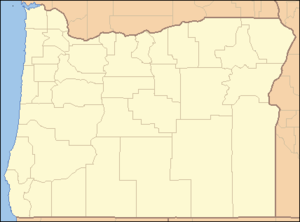White River (Oregon)
| White River | |
|
White River Falls
|
|
| Name origin: The color of the river when it carries glacial sediments | |
| Country | United States |
|---|---|
| State | Oregon |
| County | Hood River and Wasco |
| Source | Mount Hood |
| - location | Mount Hood Wilderness, Cascade Range |
| - elevation | 6,722 ft (2,049 m) |
| - coordinates | 45°20′47″N 121°41′40″W / 45.34639°N 121.69444°W |
| Mouth | Deschutes River |
| - location | near Maupin |
| - elevation | 761 ft (232 m) |
| - coordinates | 45°14′01″N 121°04′03″W / 45.23361°N 121.06750°WCoordinates: 45°14′01″N 121°04′03″W / 45.23361°N 121.06750°W |
| Length | 50 mi (80 km) |
| Basin | 409 sq mi (1,059 km2) |
| Discharge | |
| - average | 423 cu ft/s (12 m3/s) |
The White River is a tributary of the Deschutes River, approximately 50 miles (80 km) long, in north-central Oregon in the United States. It drains a scenic mountainous area of the Columbia Plateau on the east side of the Cascade Range southeast of Mount Hood. In the 1840s, a section of the Oregon Trail called the Barlow Road passed through the river corridor. This section of the road is listed on the National Register of Historic Places.
The White River originates in the high Cascades in eastern Hood River County, in the Mount Hood National Forest on the southeast flank of Mount Hood. The headwaters are just below White River Glacier in White River Canyon, the steep canyon between Timberline Lodge and Mount Hood Meadows ski areas. It flows southeast, under Oregon Route 35, another 12 miles (19 km) southeast then east for 8 miles (13 km) before turning east-northeast past Tygh Valley. It enters the Deschutes River from the west approximately 20 miles (32 km) southeast of The Dalles.
In its lower course near Tygh Valley in Wasco County, the river plunges over a 90-foot (27 m) basalt shelf in White River Falls State Park. The falls were used for hydroelectricity in the surrounding counties from 1910 until the completion of The Dalles Dam on the Columbia River in 1960.
...
Wikipedia


